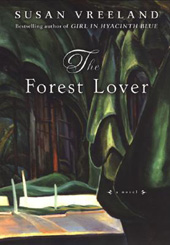 Book Review by Mary Guss April 12, 2007
Emily Carr was born in Victoria, British Columbia in 1871. Before she turned twenty she left Canada to study art in San Francisco. From there her studies took her to London, from which she returned in 1906. Back in British Columbia -- in the wildest parts of that province -- she searched for inspiration and escaoe from everything that hemmed iher in. The first page of Ms. Vreeland's novel relates:
But very soon Carr travels to the West Coast of Vancouver Island and revels in the wildness there, "the whole place juicy with life." It is in such places over the next forty years of her life that the artist finds what inspiresher, and creates her own interpretation of what she sees. Throughout her years of painting and writing -- for she was also an author -- Carr traveled not only to remote Canadian sites, but also into Southeast Alaska, as far north as Skagway. The books is a revelation of the art and culture of all the places she visits -- many of which are long gone now -- as well as a gripping story of the development of Carr's character and her art. Wanting to be the best artist she can be in order to paint what moves her profoundly, Carr travels to Paris for more study. Vreeland is able to relate equally convincingly both Carr's internal struggle to be up to the task of painting the things that have so grabbed her heart and mind as well as what it physically is in the remote locations that so moves her. Vreeland takes nuggets of information from Carr's writing and embellishes the characters met there, to help explain what formed and shaped Carr and her art. The missionaries to the Natives come in for particularly harsh treatment in the book as do those who criticize and condemn Carr's paintings without understanding them. There are lighter notes too, however -- two favorite characters are Carr's trusty and valiant dog and her squawking parrot. Carr came to be respected and appreciated by the Natives among whom she lived and painted and whose art and way of life she was trying to save through her art as it was rapidly changing and disappearing. It was a Native family who gave Carr the name Klee Wyck or "the Laughing One." In spite of her struggles against her family and the narrowness of Victorian times, Carr was always prepared to "go whiz bang and whoop it up." As the reader, you cannot help but cheer Carr on and wish that she had an easie and more conventionally happy life. But that would not be the same story. It is her ongoing efforts to be wide-open and to paint larger than life, in spite of the narrowness that surrounds her, that make Carr's story and Vreeland's novel so absorbing.
Editor's Note:
On the Web:
|
||
